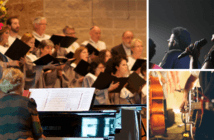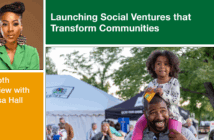How can innovation help congregations reach new and younger people? Lewis Center Director F. Douglas Powe Jr. interviews Mikka McCracken about innovation, building relationships, and creating person-focused ministries so more people know the way of Jesus and discover community, justice, and love.
Doug Powe: Mikka, you lead the Evangelical Lutheran Church in America’s (ELCA) Innovation Hub, a first-of-its-kind effort to apply human experience questions and design thinking to the church’s most pressing leadership challenges. Could you share a bit of your own story and how you came into this very creative position?
Mikka McCracken: I have been on the staff of the ECLA’s church wide organization for about 12 years. To say a little about my faith journey, I actually was baptized as a member of the ELCA before I was a citizen of the United States because I’m a Korean adoptee. I grew up in northern Minnesota where not a lot of people look like me, but where there are a lot of Lutherans, so my experience was as an “insider-outsider.” Being baptized and adopted into the Lord’s family has a different meaning for me. Some things in our tradition, such as being created in the image of God, have been important to me since childhood and are still important today. It really is part of who I am.
I had the opportunity to start leadership in the church at a national level when I was elected as a youth multicultural representative. A lot of what I’ve learned about leadership and this approach to innovation comes from recognizing that I stand on the shoulders of the leaders who came before me. Creating spaces. Trusting the wisdom and diversity in which God creates as the people show up. These have been really important for me. I also spent some time with ELCA World Hunger, the church’s relief and development ministry, working toward a just world where all are fed. I learned a ton about what it looks like to trust the expertise of people with lived experience of hunger and poverty and the transformative power of that.
Doug Powe: What has shaped your passion for innovation?
Mikka McCracken: It’s such an interesting time to be working for a denominational church. I believe COVID-19 isn’t our only pandemic. Institutional and structural racism is an ongoing pandemic. I would say polarization is, too. According to Pew Research, 63% of Americans think polarization will get worse in the future. When we imagine the role of faith communities today, innovation has to do with helping the church get out there to meet people where they are. I was listening to Rabbi Esther Lederman, who does this work at the Union of Reform Judaism. She talks about flipping the script. Now, we expect people to come to church. We teach them the text. And then they go back out into life. She talks about reversing that, so we meet people in their life with the wisdom of the text. Innovation is hard work. It’s not like rocket science. There are processes, there are tools, and there are ways that this can unlock our ministry.
Innovation is not the end in itself. It is the means to the end. In the ELCA we’re trying to imagine this mission of meeting a million new people so that more people know the way of Jesus and discover community, justice, and love. We think innovation, as a set of tools and a culture and a way of thinking, might have something to offer us in that missional pursuit.
Doug Powe: How have mainline denominations gotten to the point where we need major innovation to meet one million new people?
Mikka McCracken: I was actually born in the year that the ELCA was founded through the merger of three denominations, and it has actually been in decline ever since. The origin stories we tell ourselves are interesting. I’ve grown up with this story of the decline of mainline churches. Having worked with ECLA World Hunger where the goal was to end poverty and hunger, I jokingly say, “What could be harder than that?” Well, helping the mainline church turn around its decline might be harder. But I believe that’s the power we have in the gift of faith. So I’m in for it.
The ELCA and the Lutheran faith tradition is largely an immigrant tradition. It came over with German, Scandinavian, and Nordic folks. Where I grew up in northern Minnesota, there’s lots of lefse and lutefisk dinners. Sometimes we conflate the culture with the faith. Certainly, they’re interrelated. And they’re interrelated as we live our lives. But the question is, how do we continue to make that relevant? Especially in a country like the United States where we know the demographics of the country do not reflect the current demographics of the church. And looking ahead, the demographics of the church certainly don’t reflect what the racial and ethnic diversity of this country will look like in the future.
What brings us to this right now? The easy answer would be the pandemic. But actually that’s not the case. I think in some ways the pandemic really brought into sharper relief the trends we were already seeing. Certainly, there are some new learnings, but the pandemic largely helped heighten the focus.
Bishop Eaton, the presiding bishop of the ELCA, has a real vision for this. In 2019, she was elected on the first ballot to a second term of leadership after spending her first term traveling around the church, meeting with bishops and congregations who said, “Where are the young people? How are we going to make this faith something that we can pass to new generations, and not only those who look like the church today?” It’s really been a pleasure to join this team that’s ready to do this work.
If these were easy questions to answer, there would be easier solutions. We would have done something already. We’re on this journey. And we’re trying to be open to the movement of the Spirit as well. I don’t want to discount that as part of what’s coming together here.
Doug Powe: What’s at stake if mainline denominations don’t really start innovating now?
Mikka McCracken: So yesterday I actually was chatting with the Presiding Bishop about this question specifically. “What’s at stake?,” I asked. She said, “The gospel is at stake.” And I said, “That’s a mic drop right there. We don’t have to say anything else.”
When you look at the place of the church in society today, the majority of Americans still believe faith communities have more of a positive effect than a negative one. Lutheran Services in America touches one in 50 Americans. ELCA World Hunger is at work in over 60 countries. We have 27 colleges and universities educating upcoming generations, as well as seminaries. Not only that. I think the pursuit of meaning, purpose, and belonging is a human pursuit. The church used to have a corner on that market. Maybe in Luther’s day, it was a more significant corner on that market. Today, there’s a lot more out there, a lot of other places where people can find meaning, purpose, and belonging. So, what is the church’s unique opportunity? That’s really what we’re trying to hone in on.
We are not trying to do this work prescriptively, as if we know what’s best for you. It’s more of an exploration. We’re trying to get to know more new, young, and diverse people. Diversity defined very broadly. What’s up with those people? And the young people in the church today. What’s up with them? And what can we learn from the wisdom they bring to the table?
Doug Powe: So, how do we help churches think not just about cornering the market, but reclaiming its role in helping people find meaning, purpose, and belonging? And how does innovation help them to do it?
Mikka McCracken: One of the toolkits we’re looking at in the innovation work is human centered design, design thinking, and equity centered design. I think sometimes we’ve forgotten who our end user really is. Especially for those of us in congregational or denominal leadership roles, we are at a bit of a distance. And it’s harder to see exactly what those needs are. I don’t want to place any blame for that. I think it’s just a human experience kind of thing. But a user first perspective helps us look at one person created in the radical, beautiful image of God and say, “What’s up with that person? How can the church meet you where you’re at today?”
We’re not going to meet a million young more diverse new people by having one giant super program that’s going to meet a million new people at once. I actually suspect this is going to involve one million innovations and more micro innovations. This has a lot to do with the skills that come organically to us as people of faith — empathy, starting with each person, their experience, and their story.
Let me give an example. We’re trying to imagine what this way of Jesus looks like for those two or three generations down the road. We’ve been doing a little bit of research looking especially at Gen Z, the youngest of whom are just starting school and the oldest of whom are in college today. One of the things that came up over and over in the research was a sense of loneliness. We know that 36% of Americans say they experience serious loneliness. That includes 51% of women with children at home and over 60% of our teens.
The church should be a great place to find community. But what we heard was that people aren’t always sure about what they’ll find when they come into a congregation. Mental health needs are rising as are the number of people on the autism spectrum. For them, coming into a congregation with a huge wide-open space and a loud organ isn’t always comfortable. What does it look like to co-create a worship experience for somebody living on the spectrum? That’s a different question than the general question of how to make our worship space more inviting. If we start with one human in mind — the beautiful human probably least likely to succeed in the system we have today — we call that an equity perspective on design. Then we get to different conversations. And it also helps us understand that we don’t have to boil the ocean all at once. It’s simply the opportunity to recognize God in the person in front of us right now. We may not get it right on the first try. But we keep trying to build that relationship, iterating it over and over again together.
Doug Powe: Part of design thinking is experimentation. And whenever you experiment, you’re going to fail all the time. Part of the challenge I’ve found is that congregations see failure to be counterintuitive to their understanding of the gospel. Their read of the gospel is we have to succeed. How do we help them understand that failure is not a bad thing?
Mikka McCracken: That really resonates with me. We made little lapel pins that say “Fail Boldly.” In the Lutheran tradition, Martin Luther said “sin boldly.” And we like to say “fail boldly.” I think failure is really just another version of learning, as you’ve already pointed out. So much of what we read in the Gospel, as Jesus went about ministry, was him learning about the human experience as God’s presence on earth in action. Showing up at the well and sitting next to a woman and saying, “Hey, can I get a drink?” And learning what that conversation is like to go into the next one.
I have no question that God is excellent. I believe it with my whole heart. But we are not God. And the opportunity to be co-creators on this side of heaven is a radical responsibility, but also I’m a big fan of the story of Pentecost. God gifted the church with the Spirit to be with us and to advocate for us. We are not alone. I think we get in trouble when we act as if we’re alone or can do it alone. In the Lutheran tradition, Martin Luther defined sin as being turned in on oneself or anything that separates us from God and one another.
When I think about doing the work of innovation as people of faith, the only way we can fail is if we turn in on ourselves and set up more barriers to separate us from the amazingness that God is creating out there. It sounds a little bit cheesy, but for me, it’s all about trusting in the Spirit, working together as a community to explore what’s out there, whether that comes as the body of Christ in your imagery or whatever that looks like. When it comes to design thinking or innovation, I frankly think this is the faith community’s superpower. Other communities, for example the business community, don’t have quite the same opportunity as those who have the Spirit.
Doug Powe: I like the image of a superpower! We can start putting capes on all the churches so they can have their superpower. I love your reference to Luther’s definition of sin being turned in on oneself. Many congregations are already turned inward. How can we help them recognize this reality and the need to expand their horizons?
Mikka McCracken: In my work with ECLA World Hunger, one of things we heard from leaders, especially those the age of my parents or grandparents, was “I have spent my whole life dedicated to this ministry. My children actually are interested and serve. But they’re doing it with the Peace Corps or they’re doing it in another way. I just wish they would get engaged with the church.”
I think it’s going to be different for each person, whether it starts with reading Scripture and uncovering some wisdom there, or whether it starts with their closest relationships. I identify as a person of color. I have that in my DNA. I also happen to be married to a person who is neither Lutheran nor Christian, who’s from a culturally Jewish tradition. More and more of our families look like that. And as that trend continues there are different opportunities. The question is, can we be open to them? How can we put ourselves in that space?
The ELCA just completed a round of an initiative called Open Doors. It was specifically designed to meet this post-pandemic moment as communities are considering regathering in physical space and also the goal of meeting a million new people. For congregations trying to figure out how to meet new people or how to transition people they met virtually as they return to physical space, we provided the opportunity to apply for a small seed grant. The criteria were very basic: Are you an ELCA congregation? Do you have a concrete, actionable idea? Are you trying to meet new people? We weren’t really sure what to expect. But we absolutely knew the best learning would come from congregations trying to figure this out themselves. We didn’t want to miss the chance to learn alongside of them.
Over 1,000 congregations submitted grant applications. That’s 12% of ELCA congregations. We were just blown away by that response and the huge range of ideas. I read one application about an ice cream tricycle. There were lots of ideas — those trying to recalibrate their worship and physical space, those going outside more and being out in the community, and everything in between.
It’s not like the first thing we have to say is, “Hi! I’m a Christian. Would you like to come to church with me?” In the Innovation Lab, we’re trying to remember there are 200 steps that come before that conversation can happen. That might be the first part of the conversation. But for a lot of people, there are so many other opportunities that come before that. How might we imagine those differently together? How might the church participate more in those spaces? It isn’t just rolling out the welcome mat and insisting that people come to our front door. It’s bringing the front door to people instead.
Doug Powe: We’ve talked a lot at the institutional level. I welcome your thoughts on what your dream would be for the church. Can you complete the sentence: “I dream of a church where…”?
Mikka McCracken: I dream of a church where we tell the old, old story of Jesus and God’s love in new ways so that every person has the chance to hear it in a way that speaks to them.
Related Resources
- Leading Ideas to Reach Young Adults by Lovett H. Weems Jr.
- Take the Next Step: The Importance of Reaching More People, Younger People, and More Diverse People, a free Lewis Center video featuring Lovett H. Weems Jr.
- Putting Ourselves in the Places Where Life Happens by Keith Anderson
- Conquering the Challenges of Change by Ann A. Michel






